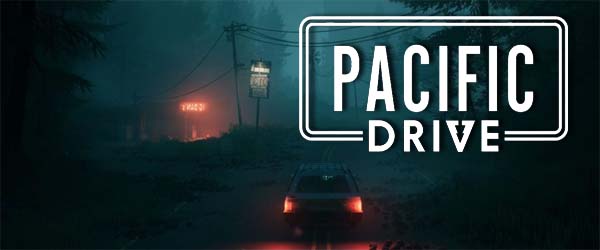
When I first saw the trailers for Pacific Drive, it was being pitched as a survival horror that takes place entirely in a car. Or at least, that was my takeaway from the initial announcements and teasers. It had me intrigued, such that I immediately wishlisted the game. However, that isn't quite what the game ended up being. Instead, Pacific Drive is more of a survival/crafting/extraction game with light-to-moderate horror elements. There's also an emphasis on logging and cataloguing everything you encounter, which nullifies much of the horror and mystery that it could have, in favor of encouraging exploration and curiosity.
The bulk of the gameplay consists of driving to different parts of the map, scavenging for materials and supplies, and using those materials to craft upgrades for your possessed station wagon. And all the while, you're scanning almost everything you encounter in order to catalogue it (from paranormal phenomena, to resources and equipment, to the different types of wrecked vehicles you find rusting along the roadside, and everything in between). Maybe I misunderstood those initial announcements and teasers. Whether I misunderstood, or the game's concept was poorly communicated, or its design simply shifted over the course of the intervening year or so (which happens), the final game errs much closer to No Man's Sky than to Resident Evil, and might even have tiny hints of inspiration from things like Outer Wilds and Portal.
The crafting focus also means that the gameplay is split almost evenly between driving and scavenging on foot. I'm constantly getting out of the car to search an abandoned building for materials, or using the various tools to break down other wrecked vehicles for their constituent parts. So the idea that the game would be played entirely from within the car also ended up not being the case. In fact, a majority of my opening hours of the game were played on foot, since so much of the early game is a series of tutorials on how to craft various tools and car parts.
Pacific Drive can be serene and beautiful, and almost zen-like.
So Pacific Drive takes a while to really get going. Whether it's the sub-genre-defining horror game that I anticipated, or a more trendy survival/crafting/extraction game with a driving gimmick, Pacific Drive still turned out to be quite good and addicting. In fact, the survival and extraction focus might even have made it a better game than what I was envisioning in my own mind.
Grab 'n' Go
Pacific Drive's core gameplay loop is more akin to an extraction shooter, except that it's single-player PvE (Player vs Environment), and the player uses a possessed, beat-up old station wagon as your primary method of locomotion and eventual escape. You choose an area from a map menu, and the specific details of the area are pseudo-randomized each time you enter (and can change if you return later). You drive around the area, collecting any resources or materials you find, avoiding paranormal hazards, and occasionally finding documents or audio logs that slowly explain what happened to the Olympic Peninsula Exclusion Zone.
But there's also a ticking clock, and this is where the "extraction shooter" influence appears. If you lollygag too long, meticulously avoiding obstacles, and gingerly collecting everything that isn't nailed down, a blaring siren will sound, and a mysterious Fortnite-esque "storm" will slowly engulf the area. If you get caught in the storm, you'll slowly take damage until you either escape or die. And the only way to escape is usually to trigger a warp portal that appears somewhere on the map. These portals can only be activated if you're more than a certain distance away, and once activated, the storm starts to rapidly expand. You have only minutes to drive halfway across the map to the portal and escape, with the storm breathing down your neck.
Each voyage is punctuated by a frantic race to a gateway portal.
[More]
7a4a2b03-cfb0-42a5-88af-2605cfaebb55|6|3.7
Tags:Pacific Drive, Ironwood Studios, Kepler Interactive, car, driving, crafting, survival, horror, extraction, Pacific Northwest, ARDA, science, anomaly, garage, road, forest
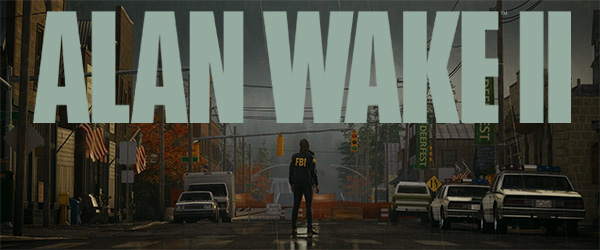
I'll give Remedy this bit of credit: in a world overrun with soul-less, design-by-committee, live-services and vehicles for micro-transaction economies, Alan Wake 2 is a game that actually has a strong creative vision and personality. It follows in the footsteps of Hideo Kojima and Death Stranding by being completely confident in itself and being un-abashedly weird. And just like with Death Stranding, that means that sometimes Alan Wake 2 is genius; other times it's confoundingly stupid and hackneyed!
It's hard even to classify Alan Wake 2 into a single genre. That goes for both narrative genre and also ludic genre. In both cases, it's kind of all over the place. At the most reductionist level, it follows the basic formula of a modern horror game: exploring creepy environments to find keys for doors, fighting monsters as an over-the-shoulder 3rd-person shooter, solving puzzles, and managing a limited inventory. So it's a "horror game", right? In fact, sometimes, it's seriously scary and disturbing. But other times, I'm questioning its "horror" status while I'm laughing out loud to a deliberate joke, or bored out of my mind because nothing scary or particularly exciting has happened in hours. Yet other times still, it's farcically campy or schlocky, and un-intentionally laughable. It's story is ridiculously out there in its concepts and execution, but somehow every beat of the plot is set up and signposted as clearly and obviously as the neon signs that point the player to the next objective in the Dark Place.
Plot twists are signposted more clearly and obviously than the neon signs that often guide the player through levels.
It's also frequently up its own ass. It is, after all, a fictional story about the power of fiction to alter reality (and our perception of reality). It even features the lead designer as a self-insert character within the story. Though surprisingly, he made himself a secondary character instead of one of the 2 playable protagonists. So it's not really about him, but he still found a way to make the entire plot revolve around that secondary character.
In the mind's eye
I feel that Alan Wake 2 is consistently at its best when its sitting firmly in its horror-mystery mode. As such, the opening couple hours of the game really pulled me in and hooked me. The game's main quest and side content are split up into various "cases" for the FBI agent protagonists to solve. There's a mechanic in which the player can retreat into Agent Saga Anderson's "Mind Space", which is an imaginary office room in which she sorts through all the clues she's gathered and strings them together on an imaginary wall in order to fit the puzzle pieces of the mystery together. Each time the player discovers a critical piece of information in the game world, it will show up in the Mind Space's filing cabinet as a new file in a case folder. Putting the clues together in the right way will unlock new lines of inquiry, and can even reveal the next objective.
Agent Anderson can review the known evidence in her imaginary Mind Space office.
Apparently, the actual game doesn't even pause, and continues to play in the background while the player is in the Mind Space. Even though the Mind Space is a full-screen environment, the character can still be attacked by enemies in the "real world". At first, I thought this would be obnoxious, but after the first time I was attacked while trying to re-arrange items on the case board in the Mind Space, I learned my lesson. After that, I actually came to realize that that needing to find a safe, peaceful space in order to let the character think about clues they've discovered (and how to proceed), really helps to emphasize the danger and stakes of the situation.
Arranging the clues in the Mind Space is not very difficult or complicated. It's not like having to solve a person's fate in Return of the Obra Dinn, or anything like that. Most of the time, the process is just going through the motions. Even when there are multiple options for where a piece of evidence can go, the solution can be easily brute-forced without the player having to know anything about what's going on.
The Case Board is an immersive quest log and objective tracker.
Even so, the Mind Space is a creative idea for presenting objectives, quest logs, story summaries, and characterization. The Mind Space at least tries to force the player to have to engage with the events of the story in a meaningful and immersive way. The player has to at least pretend to know how the various events of the story, the characters, and the McGuffins you find all fit together in the broader story in order to progress the main story or side quests.
And in fact, the entire game is about the interplay between the audience and the fiction. For most of the story, it's about the ability of fiction to re-shape people's perception of reality, but as the game goes on, it becomes more and more about the audience's ability to shape or re-shape the actual fiction. It emphasizes that any creative work is made up of both the voices of its creator(s) and also the interpretation and reception of the audience. This has always been true, with all forms of fiction and story-telling, but it's even more true with video games.
[More]
70bf8397-0bac-4efb-82b9-fb0c24ee8da7|1|5.0
Tags:Alan Wake, Alan Wake 2, Remedy, PS5, horror, fiction, shooter, mystery, investigation, light, dark, shadow, flashlight, forest, paranormal, music, cult, Federal Bureau of Investigation, Federal Bureau of Control
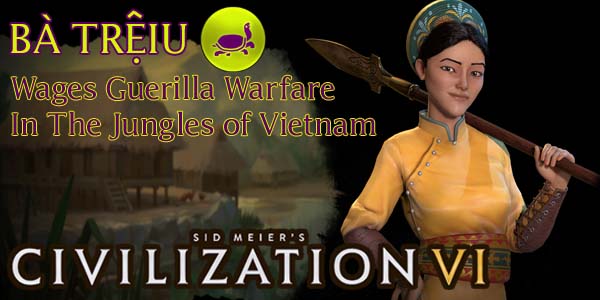
Firaxis is almost done with its New Frontiers DLC pass for Civilization VI. In January, they released a pack including the leader Bà Triệu of Vietnam. New Frontiers updates are planned through March of 2021, so I expect we'll see another pack with one or two new civilizations or leaders.

With Firaxis wrapping up with New Frontiers leaders, I may go back and write guides for the new game modes. I'm especially interested in the Corporations and recently-released Barbarian game modes. I may put up a poll on my Patreon page to let my Patrons decide what guides to create next. I hope you'll consider supporting the creation of this content on Patreon, and exercising your voting power to help influence the content I create. Your support is greatly appreciated!
The state of Vietnam, located along the eastern coast of the Indochinese Peninsula, has spent much of its existence under the rule or occupation of other states. Classical Vietnamese kingdoms existed as early as the 29th century BC. The borders of Vietnam shifted over the next couple thousand years while warlords fought each other for dominance of the region, before Vietnam was annexed by the Chinese Han Dynasty in 111 BC. After some short-lived independence movements from leaders such as the Trưng Sisters and Lady Triệu, the state finally gained full independence from the Chinese in 938 AD, but saw periods of Chinese, French colonial, and Japanese occupation in the following centuries before defeating the United States in 1975 and beginning the process of reunification under communist rule.
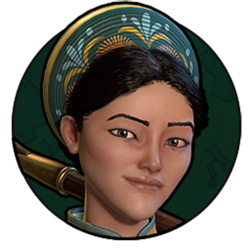
During the Three Kingdoms period of China during the third century, Bà Triệu lead an unsuccessful campaign to liberate Vietnam from Chinese occupation. Little is known about her life, and all of what is known comes from now-legendary Vietnamese sources. She is believed to have been an orphan who witnessed atrocities commited by the Chinese Wu Dynasty, and, as a teenager, raised an army in a secret military camp in the mountains. Her campaign saw two years of success at driving out Chinese occupations over the course of more than 30 battles. After the Chinese finally began taking her rebellion seriously, Lady Triệu held her ground for months before finally being defeated by the overwhelming forces of the Chinese. Some sources say she was killed in battle, while others say that she survived, but was so dismayed at her defeat that she committed suicide by throwing herself in a river (in the same fashion as the rebellious Trưng Sisters centuries earlier). While the Chinese records never bother to mention her name (or that the leader of the rebellion was a woman), she quickly became a legendary national hero among the Vietnamese, and began to take on exaggerated super-human qualities. The Ho Chi Minh army even recruited a large number of women soldiers during the American Vietnam War in keeping with the tradition set by The Trưng Sisters and Lady Triệu.
DISCLAIMER:
Civilization VI is still a "living game". Strategies for the game (and for specific leaders and civs) may change as Firaxis applies balance patches, introduces new features, or expands the game through further DLC or expansion packs, or as the Civ community discovers new strategies or exploits. As such, the following strategy guide may change from time to time. I will try to keep it up-to-date, and will make notations whenever changes are made. I'll also post links in the official 2K forums and CivFanatics, where I'll also report any changes made. If possible and practical, I will try to retain the original content of the strategy for posterity.
I welcome any feedback or suggestions that readers wish to offer. Feel free to post on the linked forums, or by posting a comment at the bottom of the page.
This guide is up to date as of the release of the "New Frontiers" January 2021 Update (ver. 1.0.9.9)
Bà Triệu is a highly defensive leader who can also be a potent threat in an offensive guerrilla war. Vietnamese cities and units all benefit from colonizing dense forests or jungles, as districts must be placed on these features. [More]
2aca68f4-1954-4b98-bbaa-7110eb4f941b|1|5.0
Tags:Sid Meier's Civilization, Civilization VI, Vietnam, Ba Treiu, nine dragon river delta, drive out the aggressor, thanh, voi chien, defender of the homeland, forest, rainforest, marsh, district, elephant
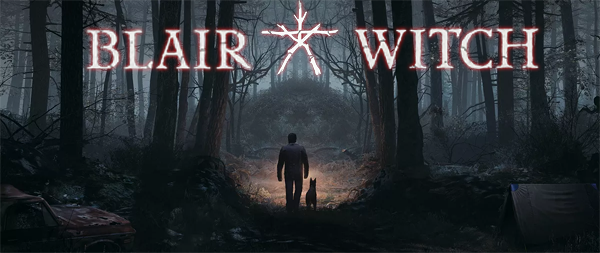
Blair Witch, as an intellectual property, is in a frustrating place similar to the Alien franchise. Both were innovative horror films that set numerous standards and conventions within their sub-genres, and which have been copied and ripped-off numerous times. Sci-fi games from Starcraft, to Metroid, to System Shock, to Dead Space have all taken heavy inspiration from Alien and Aliens. So much of the iconography of Alien and Aliens have been borrowed by these games, that when someone comes along with a game based on the Alien intellectual property, it's hard for that game to not feel like it's derivative of one (or all) of the myriad Alien impersonators.
the Blair Witch Project has similarly left a mark on the horror landscape. It single-handedly popularized the "found-footage" genre against the backdrop of a creepy, supernatural forest. Games such as Outlast, Alan Wake, and even Resident Evil VII all have a little bit of Blair Witch in their DNA. So when a game comes out that actually bears the "Blair Witch" name, it's kind of hard for it to stand out in the larger horror landscape.
Plenty of games (such as Outlast [LEFT]) have used tropes inspired by The Blair Witch Project.
This is the case with Lionsgate and Bloober Team's new Blair Witch game, exclusive to Microsoft platforms. Nothing that Blair Witch does feels particularly new or creative, even though most of the game's ideas are competently executed. Using a camcorder as a tool for navigation, exposition-delivery, and puzzle-solving feels pulled straight from Outlast or Resident Evil VII. Wandering through the woods and defeating monsters by pointing a flashlight at them gives me flashbacks to Alan Wake. Navigating the forest and occasionally picking up other people's trash also reminded me of Firewatch. Eventually, the whole game descends (rather predictably) into P.T. territory -- but, you know, without all the nuance or careful pacing that made P.T. so unnerving.
Who's a good doggy?
Blair Witch's most innovative feature is probably the dog companion (named Bullet), but even that feels pulled straight from Fallout 4. I probably would have been a bit more impressed if not for the fact that Bullet seemed to lose relevance as anything other than a monster compass, for a large chunk of the middle of the game. Without having healing items or ammunition or any other consumable supplies, the ability to send the dog out to find things feels like a sorely under-utilized mechanic.
Bullet is very well-introduced, and is integral to the early levels of the game. He finds clues for you, fetches key items, guides you to the next objective, and warns you of potential danger, all completely organically and without breaking immersion. But after a couple of hours, he just runs out of things to find and things to do. The puzzle shift away from using the dog, and more towards using the camera to do everything from manipulate the environment, to navigate mazes and looping paths, and even spotting monsters.
Your emotional support dog, Bullet, serves an integral role throughout the game.
... [More]
7a3b2c59-d35b-424f-a1cd-ecf04d6332bb|1|5.0
Tags:Blair Witch, Bloober Team, Lionsgate Games, The Blair Witch Project, Microsoft, XBox, windows, XBox Live, Steam, Good ol' Games, indie gaming, horror, found-footage, camera, forest, post-traumatic stress disorder, dog
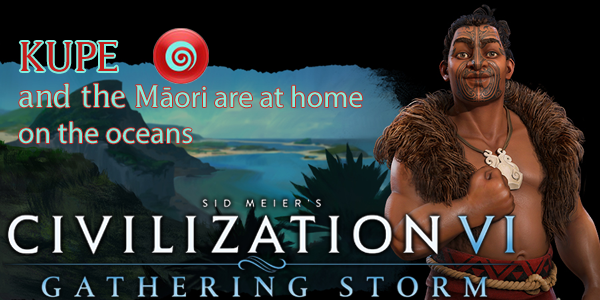
Civilization VI's second expansion, Gathering Storm recently released and has added a handful of new civilizations and leaders. I am hoping to write a strategy for each of them, but I want to start with the civilizations and leaders who are completely new to the franchise. This time, I'll be writing about one of the more interesting of the new civs and leaders: the Māori, lead by Kupe the Navigator.
Natives of the Polynesian Triangle are some of the most successful sea-faring peoples in the history of the world. Between 1400 BC and 900 BC, they had begun sailing large ocean-going craft called "waka", that enabled them to cross from Taiwan, through the Philipines, and out to the Melanesian and Samoan islands. Over the next two thousand years, they managed to colonize Pacific islands as far as Hawai'i, Easter Island, and New Zealand. Some historians even believe that they made it as far as the coast of South America! Sometime in the 13th or 14th century, settlers from Polynesia sailed west, began colonizing New Zealand, conquered the local tribes, and began to culturally diverge from their Polynesian ancestors to become the Māori.
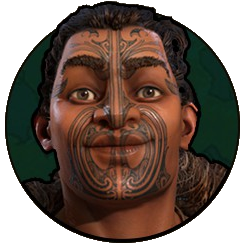
According to legend, the first Polynesian to arrive in New Zealand is Kupe the Navigator, chief of Hawaiki. Kupe is figure in Māori mythology, but like Gilgamesh, Hiawatha, and others, he is believed to be an actual historic figure. Historians have constructed accounts of Kupe's life that differ from the various oral legends of the Maori and Polynesian peoples. According to legends, Kupe sailed from Hawaiki (the mythological birthplace of the Polynesian people), along with great migration fleets, to colonize New Zealand as far back as antiquity, battling sea demons along the way. According to historians, Kupe probably found New Zealand between 750 AD and 925 AD after his cousin drowned on a fishing trip and Kupe fled across the sea with his cousin's kidnapped wife, only to return to Hawaiki later to convince others to migrate to the newly-discovered lands with him.
DISCLAIMER:
Civilization VI is still a "living game". Strategies for the game (and for specific leaders and civs) may change as Firaxis applies balance patches, introduces new features, or expands the game through further DLC or expansion packs, or as the Civ community discovers new strategies or exploits. As such, the following strategy guide may change from time to time. I will try to keep it up-to-date, and will make notations whenever changes are made. I'll also post links in the official 2K forums and CivFanatics, where I'll also report any changes made. If possible and practical, I will try to retain the original content of the strategy for posterity.
I welcome any feedback or suggestions that readers wish to offer. Feel free to post on the linked forums, or by posting a comment at the bottom of the page.
This guide is up to date as of the release of the Gathering Storm expansion's "Great Works and Trade Update" (April 2019) (ver. 1.0.0.317)
Māori are a sea-faring and environmentalist-focused civilization. They can embark and sail across ocean from the beginning of the game, and they get extra yield from unimproved feature tiles. [More]
561fb1a8-9d2a-4002-b81e-1df2c98f29d0|0|.0
Tags:Sid Meier's Civilization, Civilization VI, Civilization VI: Gathering Storm, Maori, Kupe, mana, Kupe's voyage, marae, toa, pa, fort, ocean, embark, forest, rainforest, harvest, resource, unique building, unique melee unit
|

| 12 | | | | | | | 60 | | 11 | | | | | | | 55 | | 10 | | | | | | | 50 | | 09 | | | | | | | 45 | | 08 | | | | | | | 40 | | 07 | | | | | | | 35 | | 06 | | | | | | | 30 | | 05 | | | | | | | 25 | | 04 | | | | | | | 20 | | 03 | | | | | | | 15 | | 02 | | | | | | | 10 | | 01 | | | | | | | 05 |
|